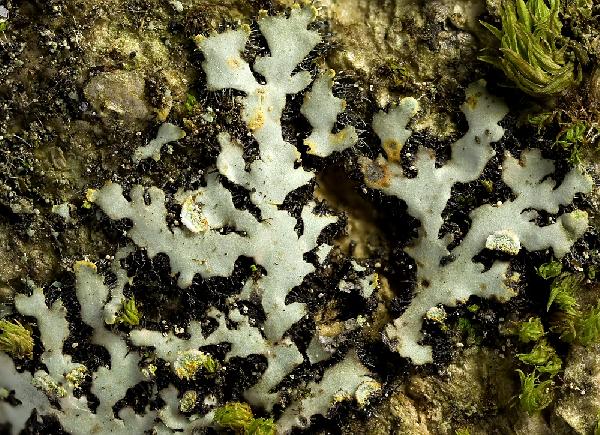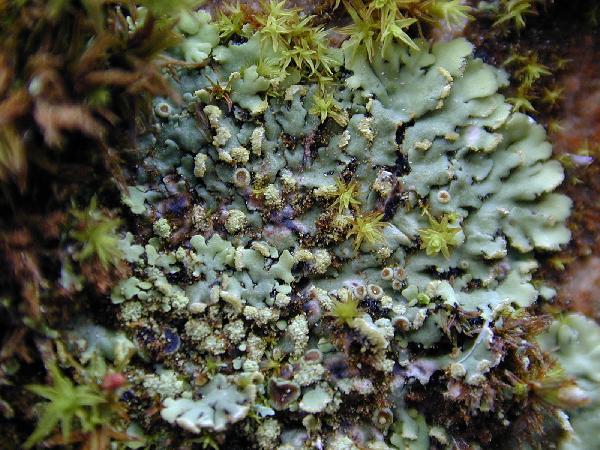Phaeophyscia endophoenicea (Harm.) Moberg
Symb. Bot. Upsal., 22, 1: 38, 1977. Basionym: Physcia obscura var. endophoenicea Harm. - Lich. de France, 4: 645, 1910 ("1909").
Synonyms: Physcia endophoenicea (Harm.) Sántha; Physcia labrata f. minor Mereschk.; Physcia labrata sensu Frey non Mereschk.; Physcia labrata var. endophoenicea (Harm.) Mereschk.; Physcia ocellata Erichsen
Description: Thallus foliose, heteromerous, dorsiventral, narrow-lobed, closely adnate only in central parts, forming orbicular to more commonly irregular, 1-3 cm wide rosettes. Lobes grey to pale brown in sun-forms, bright green when wet, (0.5-)1-1.5(-1.8) mm broad, dull to weakly shiny, epruinose, ascending at tips, with terminal, labriform soralia (laminal soralia often also present), the soredia often yellowish to reddish due to the exposed medulla, farinose, individual soredia mostly <40 µm in diam. Lower surface black, with abundant, black, simple rhizines. Upper cortex paraplectenchymatous, >22 µm thick; medulla yellow to orange-red in lower part, rarely white throughout; lower cortex paraplectenchymatous. Apothecia rare, lecanorine. Epithecium brown; hymenium and hypothecium colourless; paraphyses slender, often forked in upper part, the apical cells clavate, with a thin dark cap. Asci 8-spored, clavate, the K/I+ blue tholus penetrated by a faintly amyloid apical cushion with parallel or diverging flanks, the wall K/I-, surrounded by a K/I+ blue outer layer, Lecanora-type. Ascospores 1-septate, brown, ellipsoid, 23-28 x 9-11 µm, Physcia-type. Pycnidia rare. Conidia ellipsoid, 2-4 x c. 1 µm. Photobiont chlorococcoid. Spot tests: cortex K-, C-, KC-, P-; soralia and medulla often K+ red. Chemistry: medulla usually with skyrin, without fatty acids.
Growth form: Foliose, narrow lobed
Substrata: bark
Photobiont: green algae other than Trentepohlia
Reproductive strategy: mainly asexual, by soredia, or soredia-like structures (e.g. blastidia)
Commonnes-rarity: (info)
Alpine belt: absent
Subalpine belt: absent
Montane belt: extremely rare
Dry submediterranean belt: very rare
Humid submediterranean belt: rare
Padanian area: absent
pH of the substrata:
1 2 3 4 5
Solar irradiation:
1 2 3 4 5
Aridity:
1 2 3 4 5
Eutrophication:
1 2 3 4 5
Poleotolerance:
0 1 2 3
Altitudinal distribution:
1 2 3 4 5 6
Rarity
absent
extremely rare
very rare
rare
rather rare
rather common
common
very common
extremely common
Loading data...
Occurrence data
Predictive map
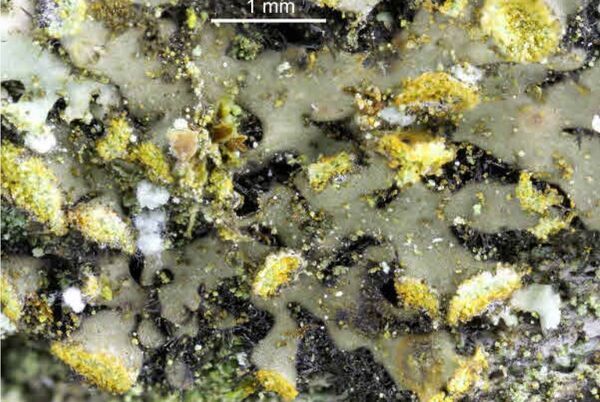
Felix Schumm – CC BY-SA 4.0
[14937], Germany, Baden-Württemberg, Kreis Esslingen, Weilheim, an Obstbäume am Fuß der Limburg, 450 m
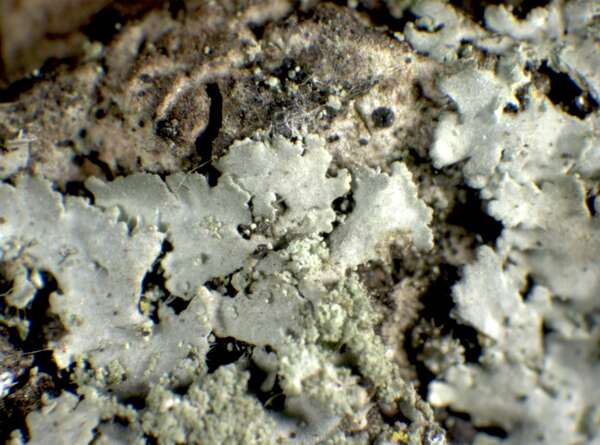
P.L. Nimis; Owner: Department of Life Sciences, University of Trieste
Herbarium: TSB (34305)
2001/12/10
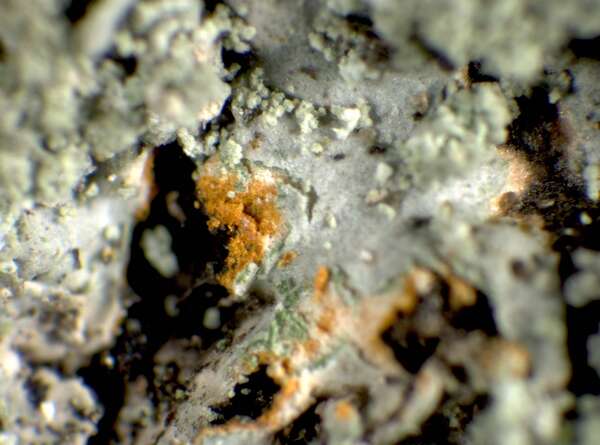
P.L. Nimis; Owner: Department of Life Sciences, University of Trieste
Herbarium: TSB (34305)
2001/12/10
detail of orange medulla
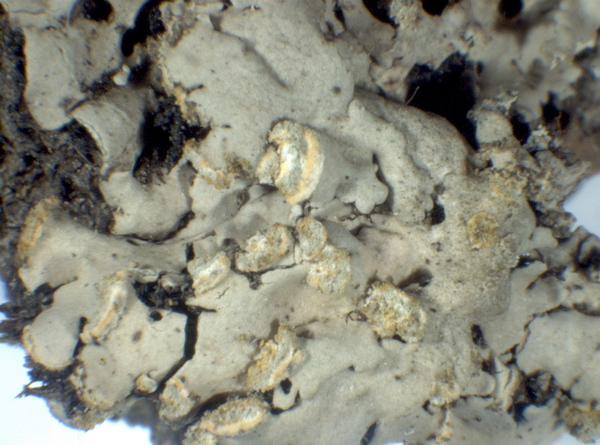
P.L.Nimis; Owner: Department of Life Sciences, University of Trieste
Herbarium: TSB (31082)
2008.03.06
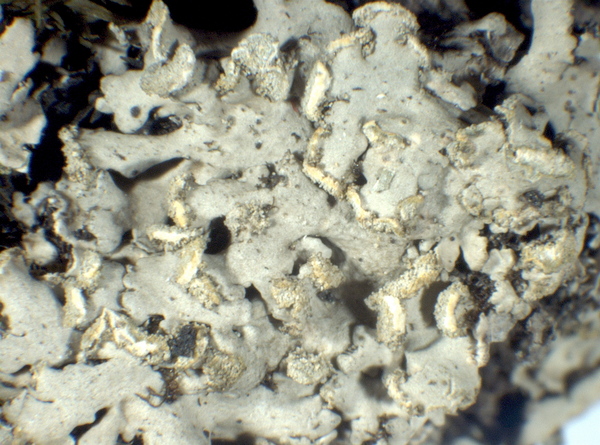
P.L.Nimis; Owner: Department of Life Sciences, University of Trieste
Herbarium: TSB (31082)
2008.03.06
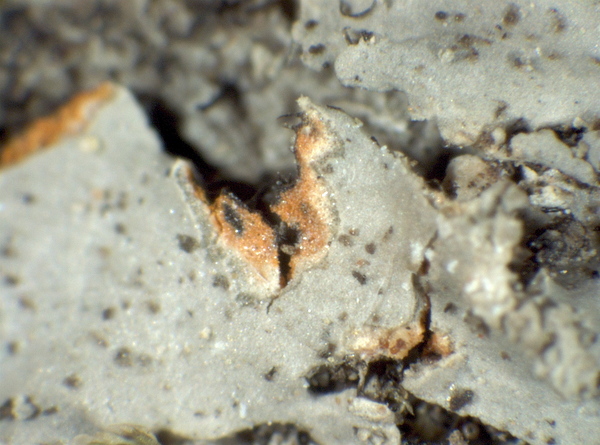
P.L.Nimis; Owner: Department of Life Sciences, University of Trieste
Herbarium: TSB (31082)
2008.03.06
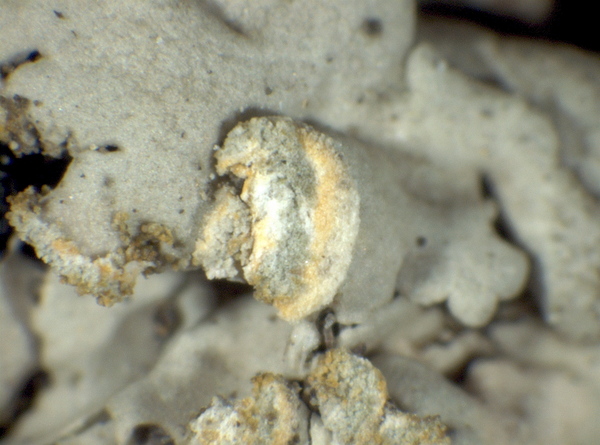
P.L.Nimis; Owner: Department of Life Sciences, University of Trieste
Herbarium: TSB (31082)
2008.03.06
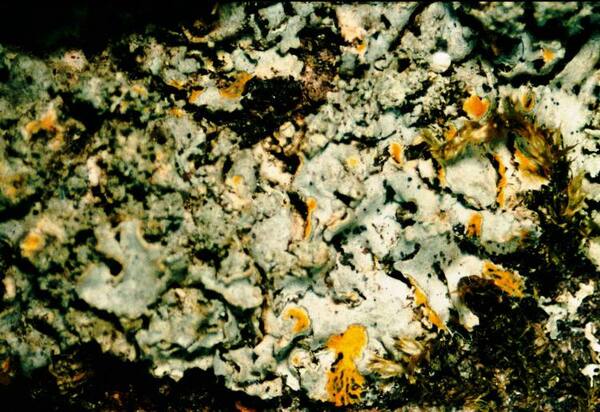
Ed Uebel; Owner: Ed Uebel – Wikimedia Commons – CC BY-SA 3.0 Unported
Growing on bark of Sugar Maple in open woods at Pellston Campground, N side of Robinson Road, Emmet County, Michigan, USA; collected and indentified by Richard E. Riefner (No. 81-270, 26 Jun 1981); specimen is now in the Lichen Herbarium of the New York Botanical Garden.
Growth form: Foliose, narrow lobed
Substrata: bark
Photobiont: green algae other than Trentepohlia
Reproductive strategy: mainly asexual, by soredia, or soredia-like structures (e.g. blastidia)
Commonnes-rarity: (info)
Alpine belt: absent
Subalpine belt: absent
Montane belt: extremely rare
Dry submediterranean belt: very rare
Humid submediterranean belt: rare
Padanian area: absent
pH of the substrata:
| 1 | 2 | 3 | 4 | 5 |
Solar irradiation:
| 1 | 2 | 3 | 4 | 5 |
Aridity:
| 1 | 2 | 3 | 4 | 5 |
Eutrophication:
| 1 | 2 | 3 | 4 | 5 |
Poleotolerance:
| 0 | 1 | 2 | 3 |
Altitudinal distribution:
| 1 | 2 | 3 | 4 | 5 | 6 |
Rarity
absent
extremely rare
very rare
rare
rather rare
rather common
common
very common
extremely common
Loading data...
Occurrence data
Predictive map

Felix Schumm – CC BY-SA 4.0
[14937], Germany, Baden-Württemberg, Kreis Esslingen, Weilheim, an Obstbäume am Fuß der Limburg, 450 m

P.L. Nimis; Owner: Department of Life Sciences, University of Trieste
Herbarium: TSB (34305)
2001/12/10

P.L. Nimis; Owner: Department of Life Sciences, University of Trieste
Herbarium: TSB (34305)
2001/12/10
detail of orange medulla

P.L.Nimis; Owner: Department of Life Sciences, University of Trieste
Herbarium: TSB (31082)
2008.03.06

P.L.Nimis; Owner: Department of Life Sciences, University of Trieste
Herbarium: TSB (31082)
2008.03.06

P.L.Nimis; Owner: Department of Life Sciences, University of Trieste
Herbarium: TSB (31082)
2008.03.06

P.L.Nimis; Owner: Department of Life Sciences, University of Trieste
Herbarium: TSB (31082)
2008.03.06



